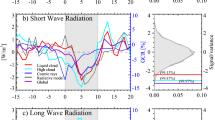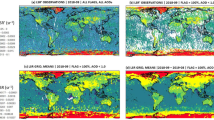Abstract
Satellite methods for the measurement of precipitation have used images obtained at visible, IR and microwave frequencies. Visible/IR methods infer precipitation from the appearance and behaviour of clouds. Microwave methods are more direct because the microwave radiation upwelling from the Earth is affected more by rain drops than by cloud droplets. These radiances viewed by a sensor outside the atmosphere are presented here as brightness temperature, the product of the thermodynamic temperature and emissivity of the surface viewed, modified by the intervening atmospheric constituents (water droplets, water vapour, gaseous absorption, and so on).
This is a preview of subscription content, access via your institution
Access options
Subscribe to this journal
Receive 51 print issues and online access
$199.00 per year
only $3.90 per issue
Buy this article
- Purchase on Springer Link
- Instant access to full article PDF
Prices may be subject to local taxes which are calculated during checkout
Similar content being viewed by others
References
Savage, R. C. & Weinman, J. A. Bull. Am. met. Soc. 56, 1272–1274 (1975).
Weinman, J. A. & Guetter, P. J. J. appl. Met. 16, 437–442 (1977).
Rodgers, E., Siddalingaiah, H., Chang, A. T. C. & Wilheit, T. J. appl. Met. 18, 978–991 (1979).
Atlas, D. & Thiele, O. Bull. Am. met. Soc. 63, 59–63 (1982).
Barrett, E. C. & Martin, D. W. The Use of Satellite Data in Rainfall Monitoring, 301–311 (Academic, London, 1981).
Gloersen, P. & Hardis, L. The Nimbus 7 Users' Guide, 213–245 (NASA, Greenbelt, Maryland, 1978).
Rodgers, E., Wilheit, T. & Siddalingaiah, H. Preprints, 4th Conf. on Hydrometeorology (American Meteorological Society, Boston, 1981).
Federal Meteorological Handbook No. 7: Weather Radar Observations (US Department of Commerce, Washington DC, 1982).
Wilson, J. W. & Brandes, E. A. Bull. Am. met. Soc. 60, 1048–1058 (1979).
Smith, E. A. IEEE Trans. Geosci. Electron. GE- 13, 123–136 (1975).
Spencer, R. W. et al. J. appl. Met. (submitted).
Wilheit, T. T. et al. J. appl. Met. 21, 1137–1145 (1982).
Hakkarinen, I. M., Rodgers, E. B. & McCumber, M. C. Conf. on Cloud Physics, 504–507 (American Meteorological Society, Boston, 1982).
Dixon, W. J. & Brown, M. B. Biomedical Computer Programs P-Series (University of California Press, 1977).
Author information
Authors and Affiliations
Rights and permissions
About this article
Cite this article
Spencer, R., Martin, D., Hinton, B. et al. Satellite microwave radiances correlated with radar rain rates over land. Nature 304, 141–143 (1983). https://doi.org/10.1038/304141a0
Received:
Accepted:
Issue Date:
DOI: https://doi.org/10.1038/304141a0
This article is cited by
-
Study on Radar Detection of One Stratiform Cloud Precipitation Process in the Central Part of the Tianshan Mountains in China
Asia-Pacific Journal of Atmospheric Sciences (2018)
-
Observations of precipitating convective systems at 92 and 183 GHz: Aircraft results
Meteorology and Atmospheric Physics (1988)
Comments
By submitting a comment you agree to abide by our Terms and Community Guidelines. If you find something abusive or that does not comply with our terms or guidelines please flag it as inappropriate.



